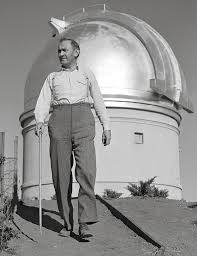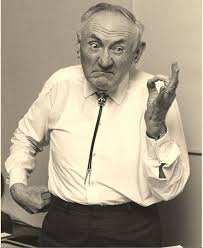


Fritz Zwicky was the first astronomer to propose the existence of dark matter, supernovas, neutron stars, galactic cosmic rays, gravitational lensing by galaxies, and galaxy clusters. However, his peers generally ignored his predictions and observations. He has been called “the most unrecognized genius of twentieth century astronomy” by many, and remains virtually unknown to the public to this day. READ MORE
Fritz Zwicky’s Extraordinary Vision
If ever a competition were held for the most unrecognized genius of twentieth century astronomy, the winner surely would be Fritz Zwicky (1898–1974). A bold and visionary scientist, Zwicky was far ahead of his time in conceiving of supernovas, neutron stars, dark matter, and gravitational lenses. His innovative work in any one of these areas would have brought fame and honors to a scientist with a more conventional personality. But Zwicky was anything but conventional. In addition to his brilliant insights that turned out to be right, he also entertained notions that were merely eccentric. To his senior colleagues he could be arrogant and abrasive. He referred contemptuously to “the useless trash in the bulging astronomical journals.” He once said, “Astronomers are spherical bastards. No matter how you look at them they are just bastards.” His colleagues did not appreciate this aggressive attitude and, mainly for that reason, despite Zwicky’s major contributions to astronomy, he remains virtually unknown to the public. READ MORE
Supernovae and neutron stars
Together with colleague Walter Baade, Zwicky pioneered and promoted the use of the first Schmidt telescopes used in a mountain-top observatory in 1935. In 1934 he and Baade coined the term “supernova” and hypothesized that supernovae were the transition of normal stars into neutron stars, as well as the origin of cosmic rays.[11][12] This was an opinion which contributed to determining the size and age of the universe subsequently.
In support of this hypothesis, Zwicky started looking for supernovae, and found a total of 120 by himself (and one more, SN 1963J, in concert with Paul Wild) over 52 years (SN 1921B through SN 1973K),[13] a record which stood until 2009 when passed by Tom Boles. READ MORE
Zwicky made a persuasive case that supernovas actually occur and ought to be observable in other galaxies. Around 1935, he convinced George Ellery Hale, the Director of Mount Wilson Observatory, to build him an 18-inch Schmidt telescope, which had an unusually wide field of view, ideal for photographing many galaxies at once. In three years, Zwicky used it to discover twelve supernovas. He then persuaded Hale to build the 48-inch Schmidt telescope at Mt. Palomar. Its primary purpose was to photograph the entire northern sky, and the resulting Palomar Observatory Sky Survey became a major cornerstone of astronomy for the next fifty years. But Zwicky also used the 48-inch telescope for “supernova patrols.” He eventually discovered 122 supernovas, still a record for any one observer.
Astronomers readily accepted supernovas, but remained doubtful about neutron stars. Zwicky persisted and was ultimately vindicated. In the late 1930s, theoreticians showed that neutron stars were compatible with nuclear physics. Then, in 1967, radio astronomers discovered the first pulsars, and the next year Thomas Gold of Cornell University showed that such objects could only be rapidly spinning neutron stars produced in supernovas. READ MORE
GP: Dr. Ian Shelton was the first to witness the birth of a supernovae since Johannes Kepler’s supernovae of 1604.. What was predicted by Fritz Swicky in the 30’s was confirmed by the discovery of Super Nova 1987a:
On a cold, dark night in February 1987 on top of a south Chilean mountain range, Dr. Ian Shelton stared at the starry sky. He embraced a moment that no other astronomer had experienced in nearly 400 years — a supernova unfolding before his very eyes. Wanting to make sure he saw what he thought he saw, Shelton went into another observatory on the mountaintop. “I put out the facts to a colleague and he said without hesitation that it was a supernova,” Shelton said. “He looked at me and said, ‘You’re kidding.’”
SN 1987A — the first supernova discovered since German astronomer Johannes Kepler, said to be the father of modern-day astronomy, observed SN 1604 some 383 years earlier — was born.
Shelton, then 30 years old, spent long months at the Los Campanas Observatory. As a student in the University of Toronto’s astronomy department, he was the resident astronomer at the university’s southern observatory, training others to use the telescope and maintaining the large device.
“Astronomers coming who scheduled time with the telescope in advance — my job was to show them how to use the telescope and make it do what they needed it to do,” he said.
One perk of the job was free time with the telescope. However, Shelton set his sights on resuscitating a telescope that had been out of service for nearly a decade.
“I thought it would be good for a nova search campaign, just to take images of the same region of the sky every night in a routine manner and then have an army of students or people at local universities go through the plates,” he said.
Ironically, the discovery came on a second night of trial runs to test whether the telescope would do what he wanted it to do.
On Feb. 24, 1987, Shelton was taking three-hour exposures of a section of the sky about the size of two hands side-by-side. High winds forced him to close the observatory roof, ending his work for the night. After he developed the images he placed them on a light tablet to check their quality. Very quickly, he realized there was an extra star on the image.
“I had looked through the telescope to line it up by eye on a star that’s close to the centre of the field,” he said. “(The supernova) was closer to the centre of the field, so I knew that it wasn’t the star I lined it up on. Comparing it to an image from the night before, “it was clear there was a faint star there before and a bright star there that night.” The significance of the discovery for the international scientific community was big. The ability to watch such a rare event from the beginning, Shelton said, turned what the community understood about astronomy and physics on its head. “This showed we didn’t understand stellar physics as well as we thought we knew,” he said.
From the supernova, physicists discovered tiny particles, called neutrinos, that were emitted during the explosion had reached Earth a few hours before the visible light. It took a few hours to get the news out to other observatories around the world. When the astronomers were unable to reach anyone by radio phone, the message was hand-delivered to the closest village a hundred kilometers away to be sent out by telegram.
Shelton and his colleagues on the mountaintop spent the next three months studying the supernova. But Shelton understood the pressure that was now on him for making one of the biggest discoveries of the decade. “When I discovered this, I had no credentials,” he said. “I couldn’t contribute past the observational aspect. There was lots of pressure to suddenly deliver and I hadn’t even really started. “I didn’t want to use this as an excuse for why I was an astronomer. I wanted to prove myself. For my own sanity and respect, I had to make sure I was doing this because I could do it.” That fall, Shelton entered graduate studies at U of T. He completed a master’s degree in science in 1990 and a doctorate in 1996.
He has since worked at several other observatories: Japan’s 8.3-metre Subaru Telescope in Hawaii, the 1.9-metre David Dunlap Observatory in Toronto and the 6.5-metre MMT Observatory south of Tucson, Ariz. He’s also worked at Athabasca University and as a professor of physics at Mount Allison University in New Brunswick.
How Far Away Is It – 2016 Update by David Butler
Link to Zwicky Transient Facility
gp: please visit this facility. Astonishing.
Teach Astronomy – Dark Matter in Clusters
http://www.teachastronomy.com/
The first good evidence for dark matter in astronomy came from observations of the Coma cluster by Fritz Zwicky in the 1930s. This Caltech astronomer measured radial velocities from many galaxies in the Coma cluster and showed that the velocity dispersion was far too high to be accounted for by visible material in the cluster. In Zwicky’s interpretation ninety percent or more of the mass of the cluster must have been invisible material or dark matter. Since that time the same argument has been applied to dozens of other clusters with the same implication. Almost all the rich clusters we can observe appear to be bound ninety percent by dark matter with visible matter in the galaxies being a minor component of their mass. This argument must be applied carefully because galaxy clusters form late in the evolution of the universe, so only the richest clusters and the most symmetric ones are suitable for using this argument.